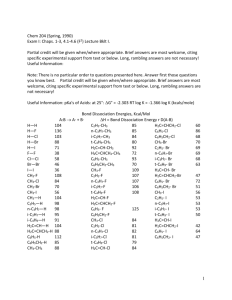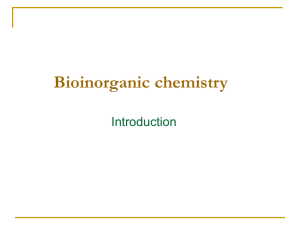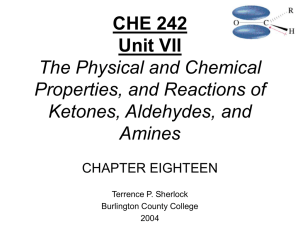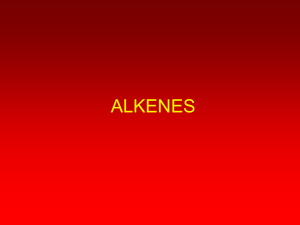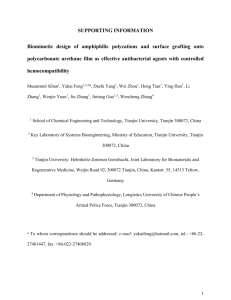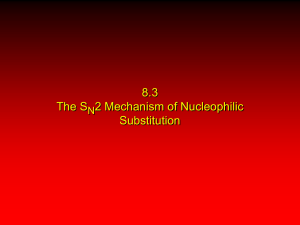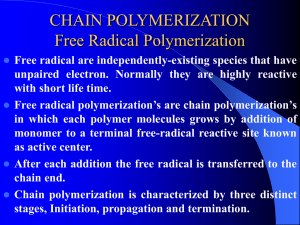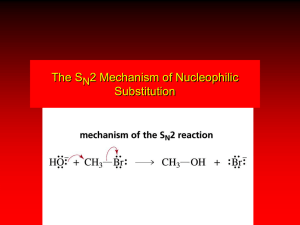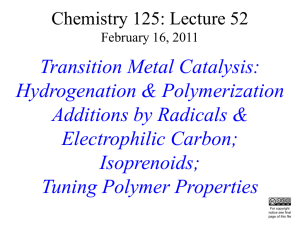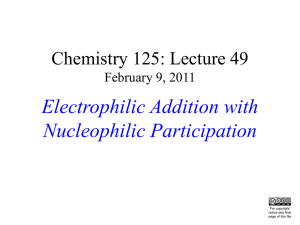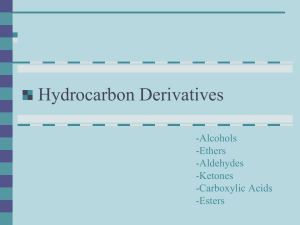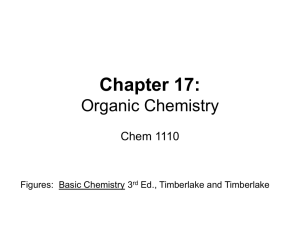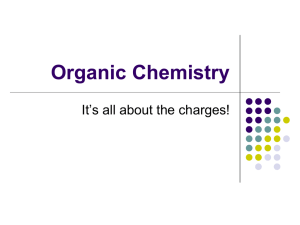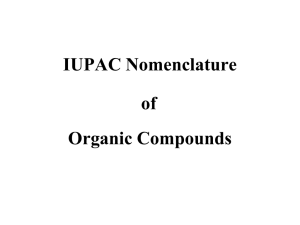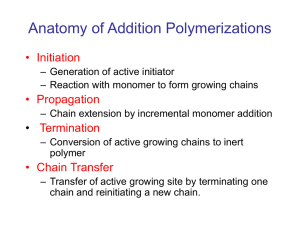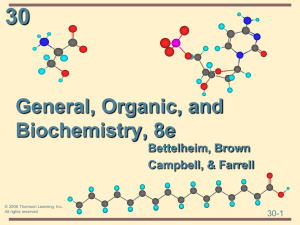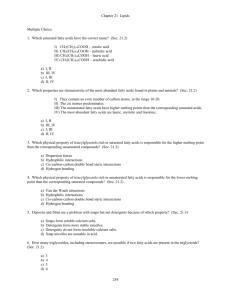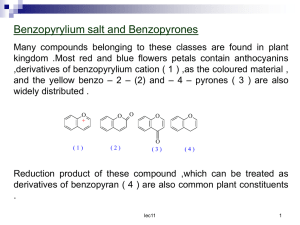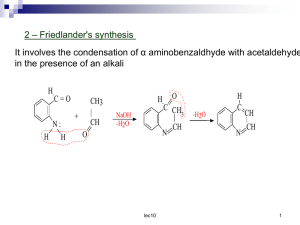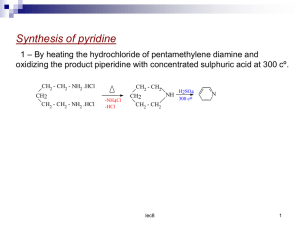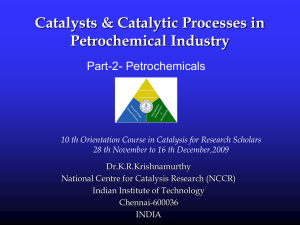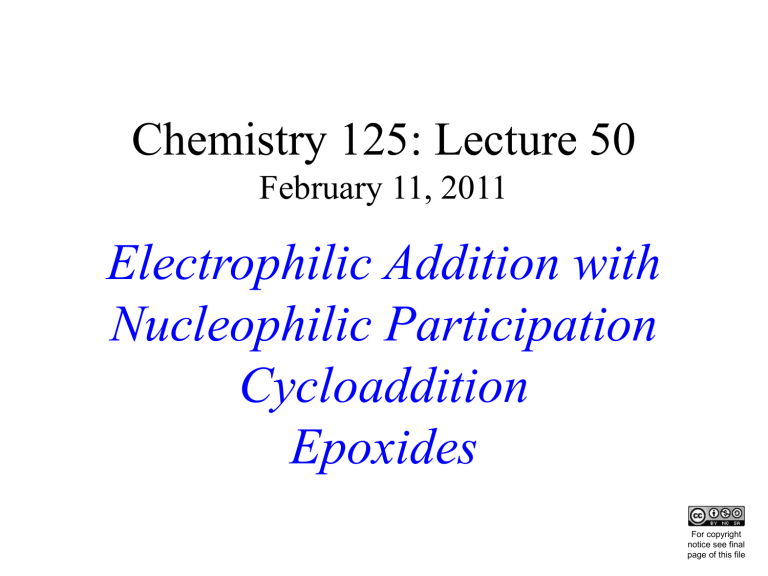
Chemistry 125: Lecture 50
February 11, 2011
Electrophilic Addition with
Nucleophilic Participation
Cycloaddition
Epoxides
This
For copyright
notice see final
page of this file
Problem:
Suggest a Multi-Step Mechanism for the
Acid-Catalyzed “Pinacol Rearrangement”
(draw nice curved arrows)
OH CH3
CH3
+
CH3
C
C
CH3
H
CH3 C
CH3 OH
CH3
C
CH3 OH
C
CH3
Methide Shift
CH3
+
C
CH3
CH3
+ H2O
O
CH3
CH3
Driving Force?
C
+
C
CH3
CH3+O H
Other “Simultaneous” Reagents
Cl2C: (Carbene)
R2BH (Hydroboration)
CH2I2 Zn/Cu (Carbenoid)
O
RC
(Epoxidation)
OOH
O3 (Ozonolysis)
H-metal (Catalytic Hydrogenation)
R-metal (Metathesis, Polymerization)
Simmons-Smith
“Carbenoid”
Zn Cu
+
CH2I2
“couple”
CH2
The next three slides suggest a plausible, but incorrect,
two-step mechanism for addition of ICH2ZnI to H2C=CH2
e
single-electron
transfer
(SET)
Metal R-X
+
Metal R-X
+
Metal R X
+
R-M X
Metal
Model for
I-Zn-CH2I
LUMO`
n
bent for transition state 4sp Zn
Cl
LUMO
+1
LUMO
HOMO
Zn
CH3
4pZn
4sZn
Model for
I-Zn-CH2I
HOMO
LUMO`
Zn-C
Model for
I-Zn-CH2I
If it were the
diiodide instead
of the model…
Cl
ZnI2 Cl
I Zn
HOMO
2”
Zn “SNCH
3
CH2 CH
Zn-CCH2 CH2
3
2
I
C-I
LUMO
But these two transition states were just guessed,
not calculated quantum mechanically…
Although the above two-step
mechanism with intermediate
IZnCH2-CH2-CH2I is plausible,
addition of IZnCH2I to H2C=CH2
probably occurs in a single step,
according to quantum mechanical
calculation*, with the bent
transition state shown below:
*
A DFT Study of the Simmons-Smith Cyclopropanation Reaction.
A. Bottoni, et al., J. Am. Chem. Soc, 1997, 119, 12300
I
Zn
ICH2ZnI
I
ICH2ZnI
HOMO-2
LUMO
(at Transition
State Geometry)
I
Zn
I
Mixes with
*
HOMO
LUMO
Epoxidation
by Peroxycarboxylic Acids
25°C
+
benzene
5 hr
+
81% yield
?
R = n-hexyl
mCPBA
meta-chloroperoxybenzoic
acid
meta-chlorobenzoic
acid
J&F sec 10.4a 423-425
Peroxyformic Acid
Orbital Energy (kcal/mole)
200
Distorted to
Transition State
for O Transfer
UMOs
0
“-allylic”
LUMO
*O-O
-200
-400
HOMO-3
OMOs
etc.
p(O
carboxylate
“leaving group”
H
“-allylic”
resonance
*O-O electrophile
“SN2 at O”
C-C nucleophile
H2C
O C
All happen
O
together with
minimal atomic H
“SN2 at H”
displacement
backside
attack
(but
not
strictly
in
parallel)
p()
*H-O+ O
O
nucleophile
electrophile
(nearby)
pC+
electrophile
CH2
H2C
CH2
Only one TS :
Transition
State
downhill motion
Geometry
after TS
O-O
Strongly
Stretched
(from ~1.5Å)
“spiro” means
two perpendicular
rings sharing
a common atom
(here O1)
O-H
Hardly
Stretched
(from ~1Å)
kH/kD ~ 1
“Concerted but
not Synchronous”
Coplanar
“Butterfly”
mechanism
(not spiro)
suggested by
Paul D. Bartlett
(1950)
calculated
J. Amer. Chem. Soc.
(1991) pp. 2338-9
Bartlett 1950
Note that arrows were
not used as carefully
in those days.
Problem:
How about now?
(compare arrows in this textbook
illustration with the mechanism on
the previous frames and try drawing
a more accurate diagram)
Stereospecificity of Epoxidation:
Concerted Syn Addition
H
C
C
CH3
H
H 3C
mCPBA
O
O
~0°C 10 hr
trans
O
H C C CH3
H 3C
H
52-60% yield
>99.5% trans
O
H 3C
C
C
H
CH3
H
cis
mCPBA
O
O
~0°C 10 hr
H3C C C CH3
H
H
52-60% yield
>99.5% cis
Pasto & Cumbo 1965
Alternative Epoxide Preparation (1936)
syn
Cl+
H3C
H
C
C
CH3
H
H2O
HOCl
H 2O
< 0°C
3 hr
H CH3
H3C
H
C
C CH
3
H
C
SN2
HO
inversion
Cl
C CH
3
H
55% yield
(distilled)
KOH
(20M)
2nd inversion
H 3C
H C
CH3
C H
H CH3
C
O
90% yield
45% over two steps
-O
H2O
90°C
2 hr
Cl
C CH
3
H
Wilson & Lucas 1936
Remember Sharpless Asymmetric Epoxidation
OR
O
RO
O
CO2Et
Ti
RO
+ Ti
ROO
••
O
OR
OO
OEt
O
allyl alcohol
OC
H
C
C
CH2
OH
H
(R)-“epoxide”
Cf. J&F Sec. 10.4b p. 426
O
O
OEt
R
R
H
CO2Et
( also pO + *C=C ) O
RO
LUMO? *
O Ti
H
HOMO?
H
C
C
C
H 2
CH
H
CH2
O
R
CO2Et
O
O
OEt
Chiral
“Oxidizing Agent”
(S)-epoxide precursor is diastereomeric!
H2C=CH2 + O2
Ag
250°C
15 atm
O
H2C CH2
(84%)*
ethylene oxide
Only 0.05% of
ethylene oxide
is used as such.
20,000,000 tons
$20 billion
per year
* The rest oxidizes
to CO2/H2O.
Raising the yield
by 5% would be
worth >$109/year.
OLD
CAMPUS
O
H2C CH2
HO- Catalysis
O
H2C CH2
H2O
20,000,000 tons
$20 billion
per year
HO
H2C CH2
OH
ethylene glycol
(antifreeze, solvents,
polymers)
of which 2/3
H+ Catalysis
O
H2C CH2
J&F Sec. 10.4c pp. 427-430
End of Lecture 50
February 11, 2011
Copyright © J. M. McBride 2011. Some rights reserved. Except for cited third-party materials, and those used by visiting
speakers, all content is licensed under a Creative Commons License (Attribution-NonCommercial-ShareAlike 3.0).
Use of this content constitutes your acceptance of the noted license and the terms and conditions of use.
Materials from Wikimedia Commons are denoted by the symbol
.
Third party materials may be subject to additional intellectual property notices, information, or restrictions.
The following attribution may be used when reusing material that is not identified as third-party content:
J. M. McBride, Chem 125. License: Creative Commons BY-NC-SA 3.0

